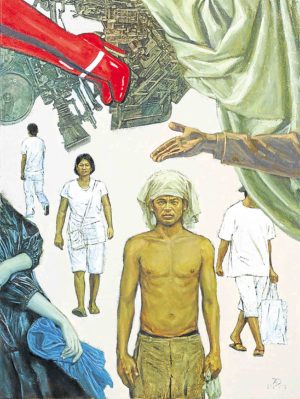
The endeavor of image making, the individual urge to craft tropes from one’s stored matrix of desire, pain and memory, is replete with defaults.
Antipas Delotavo will therefore be forgiven for his mantra: portraits of the jedermann, male or female. He is in the annals of Philippine art from the ’70s for the 50-something hunched old pedestrian menaced by the scimitar-like serif of a multinational logo in “Itak sa Puso ni Mang Juan.”
One could decry the tedium, but in the historical context of the poor being always with us, of destitution somehow outpacing whatever GDP our young country musters, portraits of common citizens, powerless, fatalistic, resigned, passive and occasionally defiant, will be a rather deep well from which to draw a career of metaphors. Socially committed painting from Giotto, to Courbet, to Martino Abellana, to Edades, to Legaspi, to Stanley Spencer, to Rivera, Siqueiros and Baen Santos, has suckled on the visage of the disenfranchised.
‘Crux Section’
Delotavo’s recent series, “Crux Section” at the Tin-aw Art Gallery goes to the kernel of the issue: What advancement do we as a species attain if majority of us are juxtaposed yet alienated from the rewards and wonders of that society to which they are not only tethered, but to whose industrial-military complexes they are indispensable yet disposable cogs? It is a theme
Delotavo has waded in for the last four decades, and from the looks of the imbalanced revivals of today’s neo-populist world, that swamp will not be drained anytime soon.
His approach for the current show is somewhat telegraphed, but not inconsistent. Acutely recognizable portraits of common folk collaged against a cult of luxe, which views them as minions: Look, dream, don’t touch, never own.
As a deliberate counter-motif to the variegated faces he has inventoried, all his dispossessed are garbed in service white, that generic blankness that does not rile their employers, their rulers, their overlords; the white of maids, au-pairs, janitors, waiters, busboys, caregivers, low-ranked nurses and utility operators.
This blanched pallor contrasts with the patina of colonial architecture, machinery linked to production and literacy, flamboyant leisure, whether fashionable or sporting, and even the dark formal frocks that extol the achievements of the
ilustrado.
Delotavo has explored this juxtaposition/alienation often enough, and he has of late given in to his fascination for the colonial landmarks and industrial machinery that are in themselves factors and symbols of skewed societal relations. His crux: No products for us, the producers?
Heritage buildings figuring in Philippine capitalist history like Escolta’s Regina Building and Iloilo’s Calle Real clash and blend with the gaggle of hoi polloi that float about disjointed in each of the 10 paintings. Coarse, sunburned peasant flesh, intricate machine parts sometimes engulfed by acanthus leaf shrubbery or baroque ornamentalia, fragments of talismans and faucet brass anting-anting that might offer an irrationally pagano-Christian reprieve from despair, all vie for our visual favor.
Delotavo is the draftsman’s draftsman: His skill at shock-of- recognition imagery rendered in assured, painterly bravura has always kept him, for some time now, at the business end of an idiom that tells it as we
know it, shows it as we see it. –CONTRIBUTED
“Crux Section” is on view until Oct. 7 at Tin-aw Art Gallery, Makati City. Call 8927522; visit www.tin-aw.com.